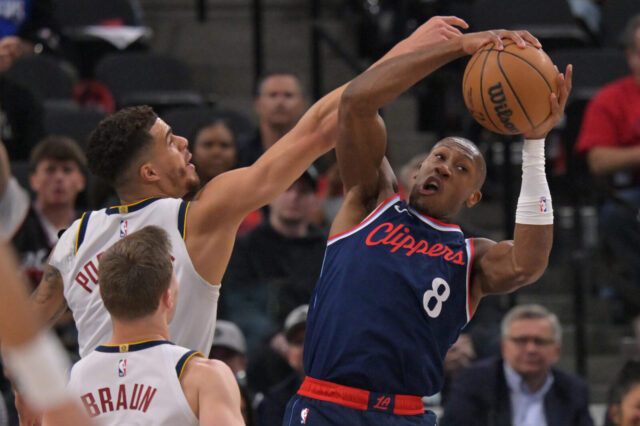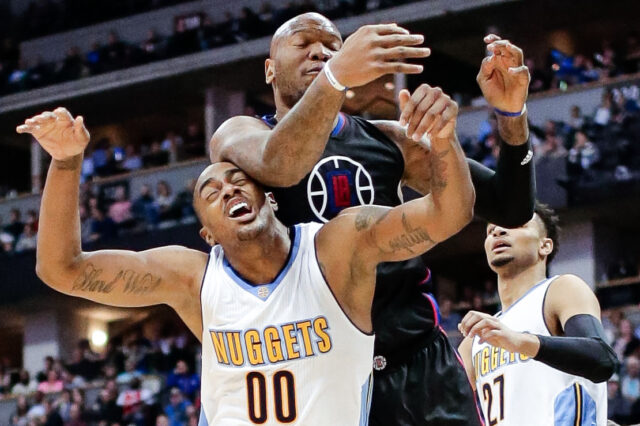I was really looking forward to this year for Will Barton.
The Denver Nuggets needed Barton badly after the All-Star break during the 2017-18 season. Gary Harris was in and out of the lineup with injuries, a more common occurrence than many want to consider, and Nikola Jokic hadn’t fully taken the next step in his evolution as a playmaker.
How did Will Barton respond to starting at shooting guard last season?
In 24 games (17 starts) he averaged 17.9 points, 5.5 rebounds, and 4.0 assists per game while shooting 47.3% from the field, 37.5% from three, and 85.7% from the free throw line. Starting caliber numbers and certainly an optimistic outlook for 2018-19.
After signing a four year deal in the offseason worth roughly $13.25 million annually, Barton was inserted into the starting lineup permanently, a unit that featured Jokic, Harris, Jamal Murray, and Paul Millsap. This unit, considering the prior data, had the potential for great things this year. And the Nuggets did accomplish great things! It just didn’t happen because of Barton. A right hip injury sidelined Thrill for 39 of the 82 games this year. The Nuggets ended up figuring out various ways to mitigate the damage, but when Barton returned, he just wasn’t the same player.
This content is no longer available.
Playing alongside Nikola Jokic and an improved ball handler in Jamal Murray, Barton’s options as a creator in the starting lineup were greatly reduced. When he had his chances though, the Nuggets struggled.
With Barton as the ball handler in pick and roll situations, he scored at a clip of 0.68 points per possession, the fourth lowest efficiency in the entire NBA among players to use as many PnR possessions as Barton.
The rest of his play types reflected a similar decline, only saved by a solid shooting season on spot up attempts.
This content is no longer available.
Injury Induced Difficulties
It’s clear that the injury and recovery process had a major impact on Barton’s performance, and the tape reflects that. Before his injury, Barton competed in a dunk contest, using his springs for legs to elevate over opposing players for acrobatic layups and jams. Now, it’s rare to see Barton get such elevation.
That’s a play Will the Thrill finishes with a reverse jam before the hip injury, or he at least stays airborne long enough to finish on the other side.
Watching Barton operate in the open floor all year generally reflected this idea for me: Barton didn’t want to finish through contact and was bothered when he had to do so. When contested in transition, Barton struggled to generate enough separation for a clean look.
In the pick and roll, finding an efficient shot can be difficult, and settling for a bad shot is even worse. This year, Barton took that to another level, reducing the shots he attempted in the restricted area by a significant margin. Reduced frequency and effectiveness at the rim generally implies aging or injury, and in this case, it’s quite clear what happened for Thrill. He increased the number of jump shots he attempted overall, but the effectiveness on floaters combined with reduced effectiveness at the rim made for a tough season inside the arc from Barton.
The one saving grace for Barton, as the play type data above shows, were his spot up opportunities. Second Spectrum classifies spot ups as shots generated either by catch-and-shoot jumpers or shots attempted after a defender runs their man off of said jumper. Barton did pretty well here during the regular season but experienced a major drought in the playoffs. He was in the 20th percentile on spot ups at just 0.77 points per possession in the playoffs, the worst efficiency in the NBA among players with as many attempts.
And the shots were mostly open. Among his 55 attempted threes in the playoffs, 45 were classified as either open or wide open by NBA.com, and yet he hit just 13 of them. 28.9 percent on open or wide open threes just isn’t going to cut it in a playoff environment.
Size Concerns at Small Forward
I have no doubt that Will Barton can start in the NBA. When healthy in the 2017-18 season, he showed just that, saving Denver’s bacon on a number of occasions with clutch baskets, playmaking, and creative shot making.
But he may not be able to do so at small forward.
During the 2018-19 season, Barton spent roughly 88% of his minutes at small forward, easily a career high. Often playing next to two of Murray, Harris, Monte Morris, and Malik Beasley, the largest opposing wing generally spent time guarding Barton. Barton was generally tasked to guard said players as well, and that was a difficult assignment. He certainly had his moments, like his performance defending Paul George in crucial games late in the season. Most of the time, opposing wings had their way with Will. Kevin Durant and Klay Thompson demolished Denver. Luka Doncic had an amazing performance on national TV. Bojan Bogdanovic dropped 35 points on him. Both Jimmy Butler and JJ Redick dominated Denver in a contest the Nuggets could have won.
There were a lot of moments that reminded Nuggets fans that Will, though he has the heart of a LeBron James sized human, is listed at just 6’6 and 190 pounds and probably weighs less than that. He has wiry strength, but not the kind needed to handle small forwards on a consistent basis. Combine that with the talent currently in place on the wing among the last three teams standing: Kevin Durant, Klay Thompson, Khris Middleton, Giannis Antetokounmpo, Kawhi Leonard. None of those guys are going away (except maybe KD) and Middleton and Kawhi might come to the Western Conference in the offseason. Add that to the list of sizable wings already in the West like LeBron James, Brandon Ingram, Paul George, Joe Ingles, Danilo Gallinari, James Harden, Luka Doncic, and DeMar DeRozan, and it’s possible that Barton starting at the 3 is an experiment that needs to end.
How to handle a change
There are a variety of questions that the Nuggets must answer with Barton going forward.
- Do the Nuggets believe Will Barton will return to form?
- Can Will Barton play small forward long term?
- If the answer is no, how can Denver handle the log jam at shooting guard?
For question 1, I believe Will Barton lacked the health and explosiveness to operate at peak performance this year, and he was put in an unfair position starting at small forward to make up for that. This version of Barton is not the version Nuggets fans should get used to, as he will work hard during the offseason to recover physically. So much of his negative performance was tied to the physical effects of sitting out for so many games, but he should be better going forward.
For question 2, I think it’s safe to say that the answer is no. At least, not in a permanent role. The playoffs are about finding the opposing team’s weak spots and applying pressure. Barton at small forward is a definite weak spot. Barton at shooting guard though? Clearly not. He can operate as a small forward in advantageous situations, especially when he isn’t facing one of the above taller threats on the perimeter, but asking him to permanently guard those players does him a disservice. Denver doesn’t have the personnel to switch those matchups either because Murray and Harris are each 6’4, so it’s all on Barton most of the time.
That brings it to question 3 and how Denver handles the shooting guard log jam. With Gary Harris currently entrenched as the starter and Malik Beasley right on his heels as the backup, the Nuggets appear set at the 2 going forward. They can either continue playing Barton at small forward, not play either him or Beasley, or move one of the two guys for another player.
I would caution against trading Beasley though. The 22-year-old shot 47.4% from the field and 40.2% from three off the bench this year. Very few bench players in the NBA managed that kind of efficiency last year, and the Nuggets had two of them in Beasley and Monte Morris. Dismantling that advantage would be dangerous. Not to mention, both guys are cheap right now and don’t have to be paid until at least the 2020 offseason.
So that leaves trading Barton as a possible option, but it’s very difficult to move players at Barton’s price point after they have a bad year. There are places that might consider a deal though. The Indiana Pacers thought they were getting a bargain when they signed Tyreke Evans in the offseason, but it didn’t work out. Barton could fill the void there as a sixth man. The Detroit Pistons lacked creators both in the starting lineup and on the bench, finishing the year starting Bruce Brown and Wayne Ellington on the wing. They could use Barton to help lighten the load on Blake Griffin.
But I would caution against this option as well. The Nuggets just won 54 games with Barton either not playing or playing at a level below his previous standard. The Nuggets have a great culture of continuity, trust, and an excellent locker room chemistry. Moving Barton would not only change the on court dynamic, but also remove one of the most important voices from the locker room. It seems probable that the Nuggets and Isaiah Thomas will part ways. If Barton goes too, Denver will lose the two most vocal veterans on the roster.
Not all of the roster moves can be made on a spreadsheet. The Nuggets front office knows this, and they will assess the situation before determining if they can actually make a move without causing other issues. I’d wager that they can, especially given where the Nuggets are in their rebuild (i.e. contending now) but I’m not in the locker room as often as others are and can’t speak to those dynamics.
Whatever the case may be, the Nuggets have a tough choice with Will Barton. It doesn’t seem tenable to keep doing the same thing with this starting lineup going forward. As the Nuggets attempt to win a championship, they must account for their weaknesses with the current core players. Murray and Jokic aren’t versatile defenders and need both length and quickness at each position to cover for them. The small forward must also either be a low usage role or efficient in whatever usage is required. Barton was supposed to provide that this year, and maybe he still can in small doses, but it’s looking less likely. In addition, the Nuggets have young players that require minutes to develop. Michael Porter Jr. is on the way, and Vlatko Cancar may be as well.
Finally, Denver’s best avenue for improvement in free agency is at small forward. There aren’t many options that are better than the other starters that would also consider the Nuggets, but if Jimmy Butler, Khris Middleton, or even other solid fits like Danny Green or Trevor Ariza emerged, then it would be in Denver’s best interest to go in that direction.
That may put Barton in a tough spot.


